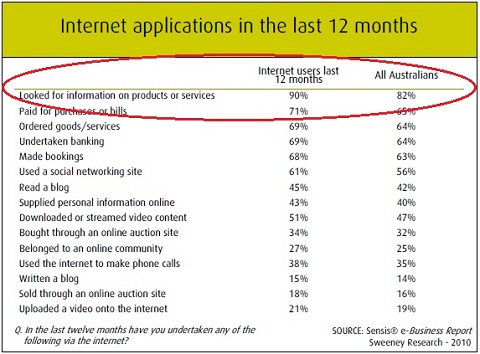The world of being found is changing quickly. For years now the phone books were a 'must' for businesses of all types, now we're all moving online at an astonishing rate. According to Nielsen, 80.1% of Australia’s population were online in 2010 (= 17.03 million people). A recent Sensis report claimed that 90% of Australian internet users used the internet to look for information on products or services.
Taking into consideration Google’s 94% market share in Australia, we can deduce that 14.41 million Australians have used Google in 2010. That’s almost 68% of the entire Australian population. No other site has this kind of penetration! This represents a rapid growth over the last three years. In fact the latest trend points to a huge increase in using mobile phones for searching for businesses and services, an area Google very keen to expand quickly, and for good reason. A recently published statistics indicate that 41% of all mobile phone users in Australia access the web, with searching for products and services listed as the 4th most popular activity at 56% which represents a 15% increase over the previous year.
Organise Internet has been in THE SEARCH BUSINESS for many years and our accumulated experience is reflected in our mature and practical approach to online developments. Our deep knowledge of other Google products and services really helps navigate this relatively new area of business marketing. So if you're looking at getting found by the people who want to find you, talk to us. We're not script kiddies or back room operators, we know a lot about search and we're happy to help you get the results you're looking for.
Email David or Danis or call us on (02) 4340 5706 and book a low cost briefing session. We're bound to surprise you about the possibilities for those that adopt a flexible mature approach.
Taking into consideration Google’s 94% market share in Australia, we can deduce that 14.41 million Australians have used Google in 2010. That’s almost 68% of the entire Australian population. No other site has this kind of penetration! This represents a rapid growth over the last three years. In fact the latest trend points to a huge increase in using mobile phones for searching for businesses and services, an area Google very keen to expand quickly, and for good reason. A recently published statistics indicate that 41% of all mobile phone users in Australia access the web, with searching for products and services listed as the 4th most popular activity at 56% which represents a 15% increase over the previous year.
Organise Internet has been in THE SEARCH BUSINESS for many years and our accumulated experience is reflected in our mature and practical approach to online developments. Our deep knowledge of other Google products and services really helps navigate this relatively new area of business marketing. So if you're looking at getting found by the people who want to find you, talk to us. We're not script kiddies or back room operators, we know a lot about search and we're happy to help you get the results you're looking for.
Email David or Danis or call us on (02) 4340 5706 and book a low cost briefing session. We're bound to surprise you about the possibilities for those that adopt a flexible mature approach.



